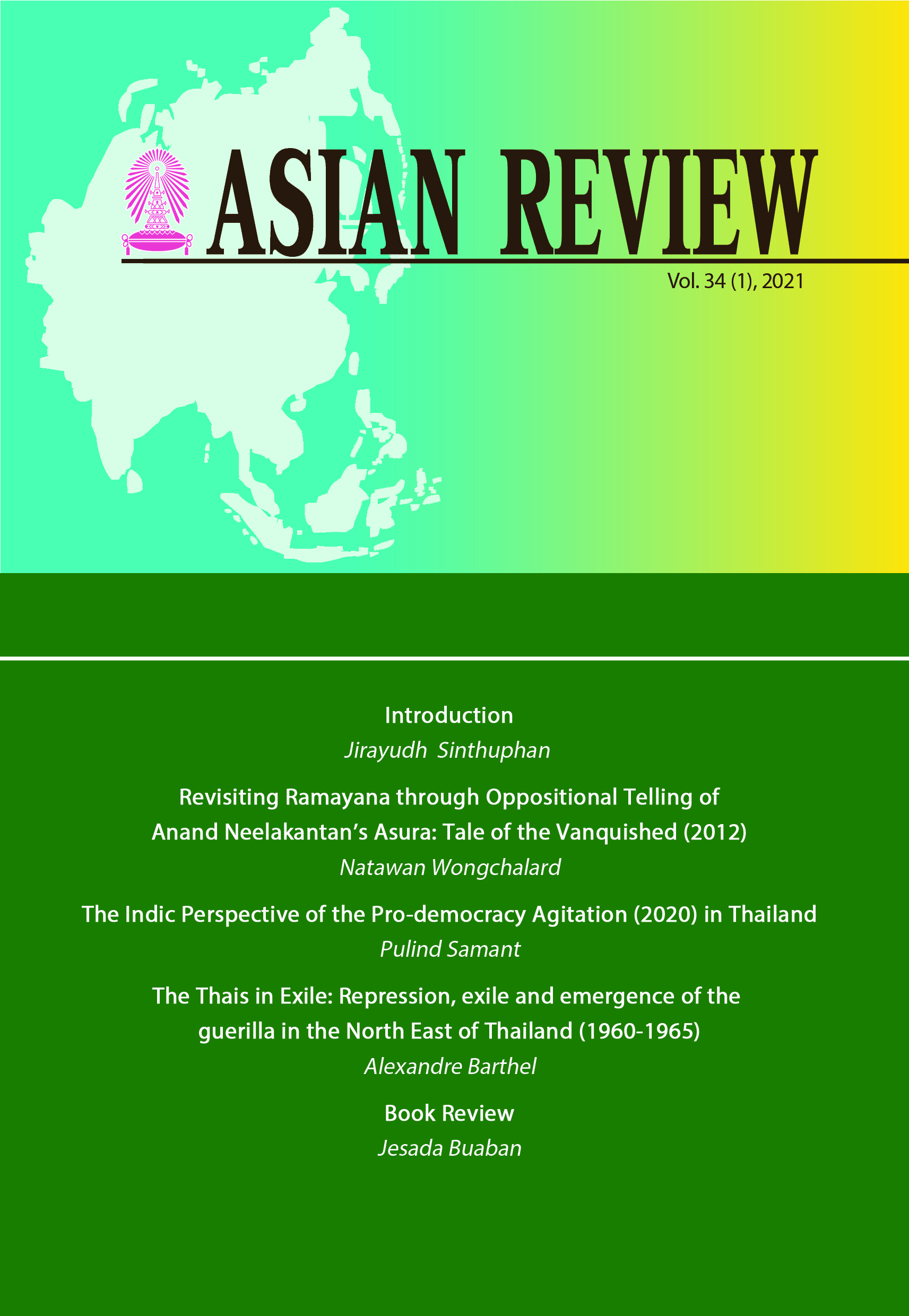The Indic Perspective of the Pro-democracy Agitation (2020) in Thailand
Keywords:
Thailand, Agitation, Monarchy, Indic, CivilizationAbstract
The pro-democracy agitation in Thailand, which attacked the institution of Thai monarchy, the strongest pillar of the Thai society, can be interpreted in India as an attack on the Thai branch of the common Indic civilisational roots, exemplified by the royal title Rama. There is a long history of attack on the institution of monarchy in the Southeast Asian neighbourhood of Thailand, from Laos to Indonesia, where a pattern of downfall of royalty followed by gradual weakening of the state can be observed. Thailand can be considered, within the region, as being culturally closest to India, apart from being a key player in India’s extended, and geo-strategically important neighbourhood. India can therefore be justified in feeling concerned about the said agitation, its future course, as well as its geopolitical implications, at the backdrop of a perceivable dimension of an ongoing struggle between Indic and Sinic civilisations.
References
BBC News. 2020. “The student daring to challenge Thailand’s monarchy” https://www.bbc.com/news/world-asia-54182002
Bennett, James C. 2004. “Explaining the Anglosphere”. The Guardian. https://www.theguardian.com/world/2004/oct/28/uselections2004.usa4
Basu Prasenjit K. 2017, “Asia Reborn”, 306. New Delhi: Aleph Book Company.
Chaloemtiarana, Thak. 2014. “Are We Them? Textual and Literary Representations of the Chinese in Twentieth-Century Thailand” Centre for South East Asian Studies Journal, Vol. 3, No. 3. https://englishkyoto-seas.org/2014/12/vol-3-no-3-thak-chaloemtiarana/
Charoengpong, Sawitree. “Rabindranath Tagore in Thailand: His Visit and Its Impact”. https://embassyofindiabangkok.gov.in/pdf/Rabindranath%20Tagore.pdf
Coedes, George, Cowing, Susan B., and Vella, Walter. 1968. “Indianised States of South East Asia”, 34. Honolulu East-west Centre Press.
Coedes, George, Cowing, Susan B., and Vella, Walter. 1968. “Indianised States of South East Asia”, 250-251. Honolulu East-west Centre Press.
Coedes, George, Cowing, Susan B., and Vella, Walter. 1968. “Indianised States of South East Asia”, 253. Honolulu East-west Centre Press.
Dipanjan Roy Chaudhury. 2020. Thailand delays plan to buy Chinese submarines; presents alternate to Beijing’s Kra canal proposal.ET Bureau. https://economictimes.indiatimes.com/news/defence/thailand-delaysplan-to-buy- chinese-submarines-presents-alternate-to-beijings-kra-canal-/articleshow/77932982.cms?from=mdr
Freitag, Ulrike. 1997. “Hadhrami Traders, Scholars and Statesmen in the Indian Ocean,1750s to 1960s”, edited by Ulrike Freitag and William G. Clarence-smith, 32–34. Leiden: BRILL.
Grousset, Rene (1932) and Quaritch Wales, H.G. (1933) as quoted by Nehru, Jawaharlal.1946. “The Discovery of India”, 201 and 203 respectively. New York: John Day Co.
Hirth, Friedrich. 1896. “Chao Ju-kua: A New source of Medieval Geography”, The Journal of the Royal Asiatic Society of Great Britain and Ireland, 65-66. Cambridge University Press.
Huntington, Samuel. 1993. “The Clash of Civilisations”, 22. Foreign Affairs, Vol. 72, No. 3 (Summer, 22-49). Council on Foreign Relations.
Lt. Gen. Prakash Katoch (Retd.). 2020. “Kra Canal project cancellation will upset Beijing’s plans in IOR”. South Asia Monitor. https://southasiamonitor.org/spotlight/kra-canal-project-cancellation-will-upset-beijings-plans-ior
Majumdar Ramesh Chandra. 1937. “Ancient Indian Colonies in the Far East, Vol.II, Suvarnadvipa, Part I – Political History”, 37. Calcutta: Modern Publishing Syndicate.
Majumdar Ramesh Chandra. 1944. “Hindu Colonies in the Far East”, 19. Calcutta: S.C. Das.
Nehru, Jawaharlal. 1946. “The Discovery of India”, 203. New York: John Day Co.
Nye, Joseph S. Jr. 2004. “Soft Power: Means to Success in World Politics”. UK: Hachette.
Panikkar, K.M. 1969. “Survey of Indian History”, 96. Bombay [Mumbai]: Asia Publishing House.
Row, James. 2020. “Behind Thailand’s Protests, Cracks in the Establishment”, The Diplomat. https://thediplomat.com/2020/08/behind-thailandsprotests-cracks-in-the-establishment/
Sanyal, Sanjeev. 2016. “The Ocean of Churn: How the Indian Ocean Has Shaped Human History”, 5. New Delhi: Penguin Random House.
Sanyal, Sanjeev. 2016. “The Ocean of Churn: How the Indian Ocean Has Shaped Human History”, 155-156. New Delhi: Penguin Random House.
Slamet, Muljana. 1968. “Collapse of Hindu-Javanese kingdom and the emergence of the Islamic Countries in the Archipelago”.
The British Academy. 2019.”Anglosphere” definition and meaning – Collins English Dictionary. https://www.collinsdictionary.com/dictionary/english/anglosphere
The Indian Express. 2020. “Explained: What is Behind the Thailand Protests? What is the Government Doing?”. Bangkok: Reuters. https://indianexpress.com/article/explained/thailand-protests-explained-6734960/
The New York Times. 1990. “Laotian Royal Family Died in Prison Camp”.https://www.nytimes.com/1990/02/08/opinion/l-laotian-royal-familydied-in-prison-camp-282890.html
Tripathi Suryakanti. 2015. “India and South East Asia: Contacts and Contiguous Cultures in Outreach and Overlap” in Ram Amar Nath (Ed.), India’s Asia-Pacific Engagement: Impulses and Imperatives: 228. New Delhi: Manohar Publishers.
Wellings, Ben. and Mycock, Andrew. 2019. “The Anglosphere: Continuity, Dissonance and Location”. London: The British Academy. https://www.thebritishacademy.ac.uk/publishing/proceedings-britishacademy/proceedings-british-academy-the-anglosphere-continuity-dissonance-and-location
Downloads
Published
How to Cite
Issue
Section
License
Published articles are under the copyright of the Instiute of Asian Studies, Chulalongkorn University. Partially or totally publication of an article elsewhere is possible only after the consent from the editors.







